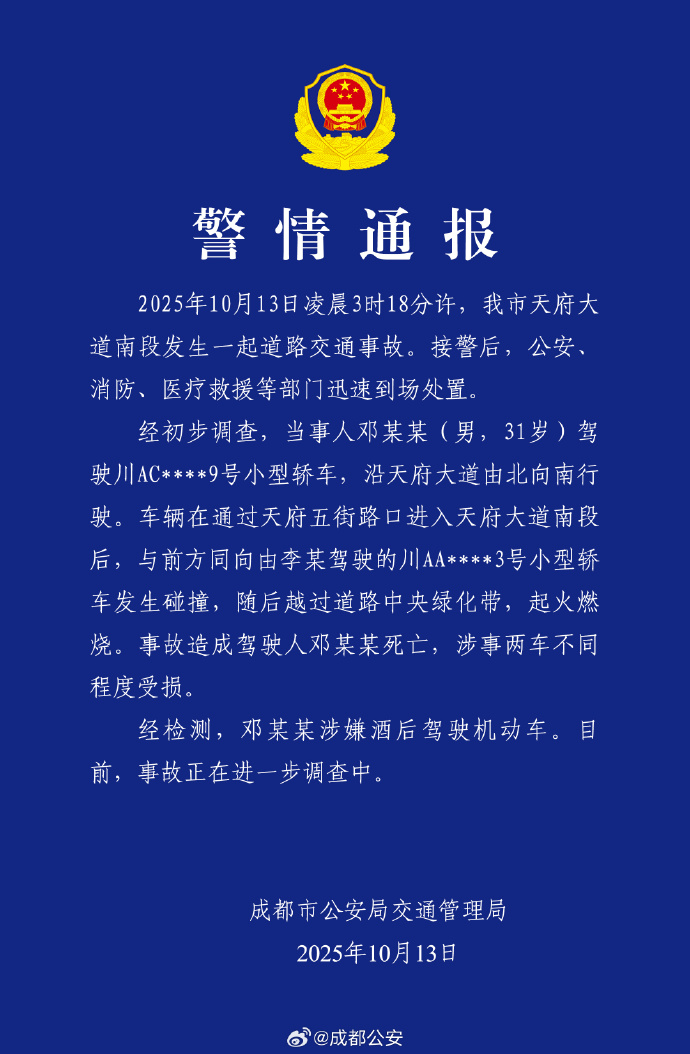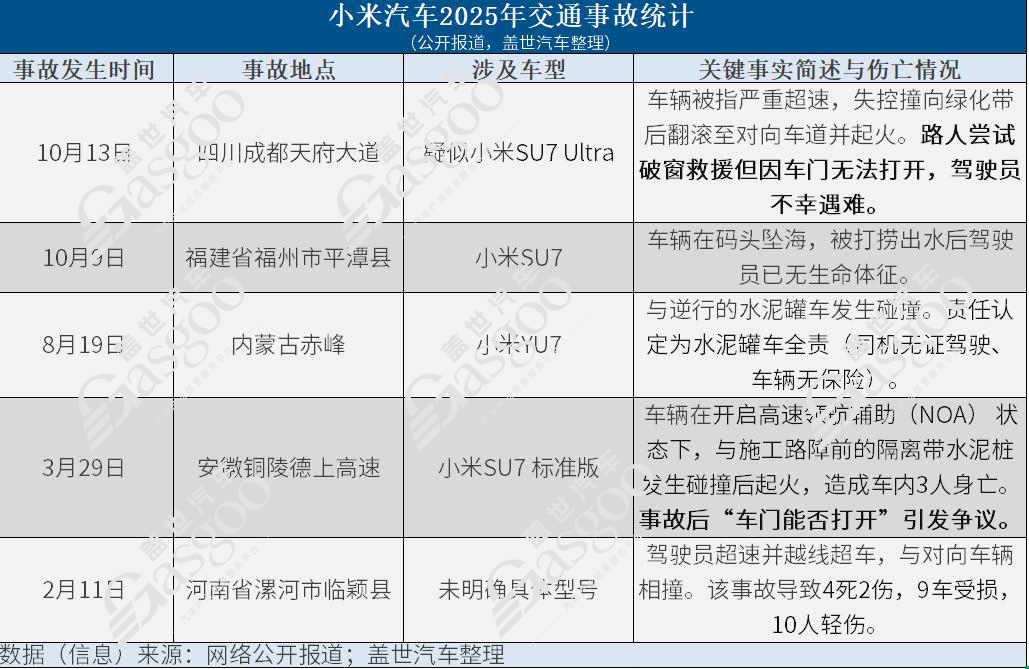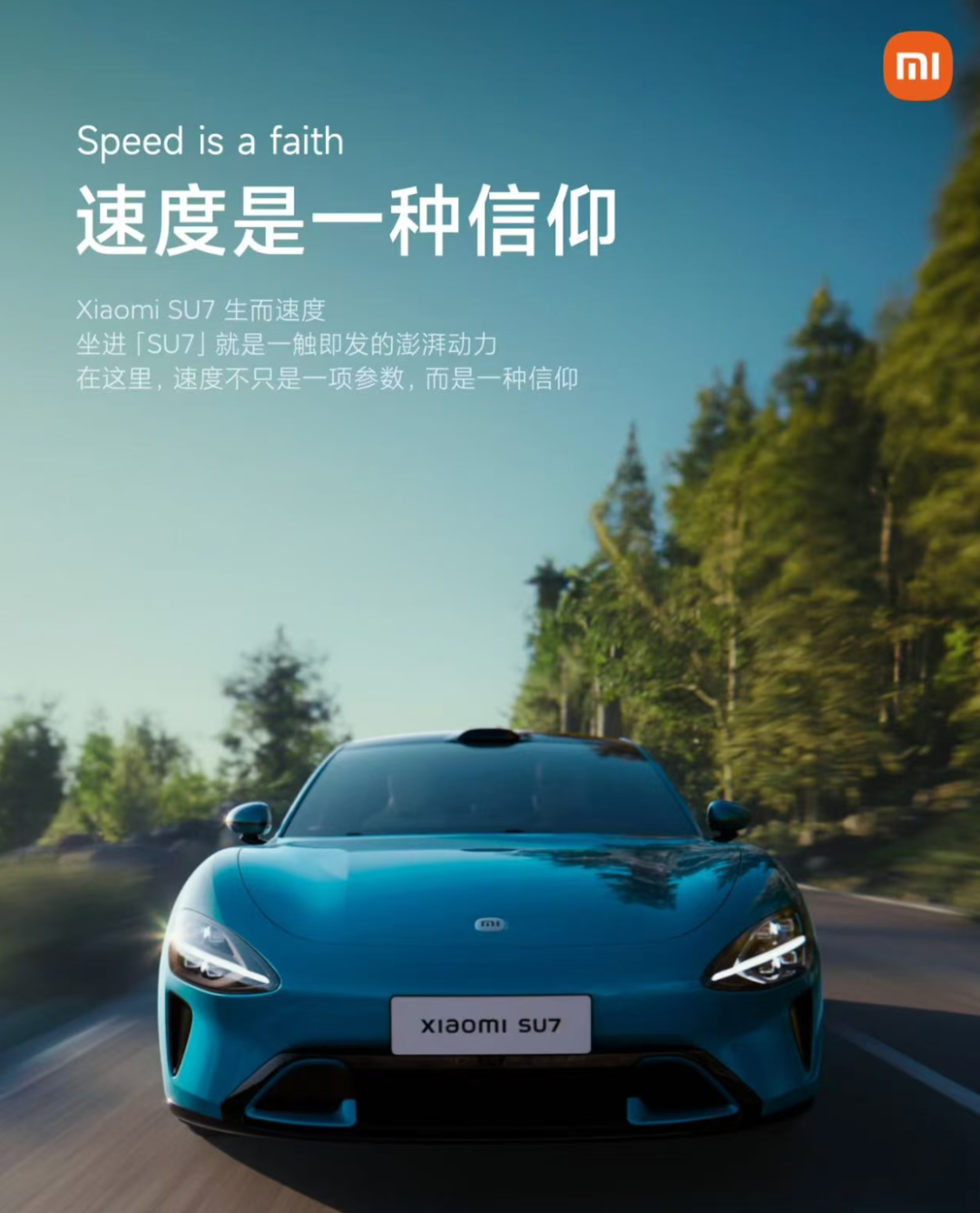Who Was Trapped by the Jammed Door in the Xiaomi SU7 Collision Fire?
Lead-in: What is the reason behind the car door that won't open?
In the early hours of October 13, on the southern section of Tianfu Avenue in Chengdu, a Xiaomi SU7 collided with the vehicle in front, crossed the central green belt, and caught fire. The accident resulted in the death of the driver, Deng, and both vehicles involved were damaged to varying degrees.

Image source: Chengdu Police
The accident scene was very tragic. From videos circulating online, it can be seen that although passersby made every effort to rescue, the doors of the accident vehicle could not be opened, and the rescue ultimately failed. The investigation into the accident is currently ongoing.
As of the time of writing, no official or authoritative departments have released more detailed information and data regarding this incident. Gaishi Automobile can only make reasonable inferences based on the information that has been made public.What we are most concerned about is...What is the reason for that door that cannot be opened? That door, which cannot be opened, traps not only the victims but many others as well.
Preliminary Review of the Xiaomi Car Accident Process
Based on the video circulating online and the information disclosed by Chengdu police, the basic situation of the Xiaomi car accident is already quite clear.
In the early morning of October 13, a netizen captured a traffic accident on the main road of Tianfu Avenue in Chengdu, involving a vehicle suspected to be a Xiaomi SU7 Ultra.
According to videos, images from the accident scene, and information from eyewitnesses, the vehicle involved first swayed while in motion, then lost control at high speed, collided with the green belt, rolled over into the opposite lane, and caught fire.
After the vehicle caught fire, the driver was trapped inside, and several passersby immediately came forward to assist in the rescue. Some people used their bare hands or tools to smash the car windows, but the doors could not be opened. Videos circulating online also show this.Later, someone found a way to smash the car window, but the door still wouldn't open.
The report from the Traffic Management Bureau of the Chengdu Public Security Bureau also reconstructed the process of the accident:
According to the preliminary investigation, the party involved, Deng Moumou (male, 31 years old), was driving a small car with the license plate number Chuan AC****9, traveling southbound on Tianfu Avenue. After passing through the intersection with Tianfu Fifth Street and entering the southern section of Tianfu Avenue, the vehicle collided with a small car with the license plate number Chuan AA****3 driven by Li Mou. Subsequently, it crossed the central green belt of the road and caught fire.
The Chengdu traffic police specifically mentioned in the report that "the driver is suspected of driving a motor vehicle under the influence of alcohol," which likely means that alcohol was detected in the tissues of the deceased.
As of this press release, the brand involved has not yet issued any related statement.
The car door that won't open, what is the cause?
From the perspective of traffic regulations, the responsibility for the Xiaomi car accident in Chengdu is already very clear; even without drunk driving, it is the driver's responsibility.The remaining question is why the car door couldn't be opened.
This is not the first time Xiaomi cars have had issues with doors not opening after an accident. On March 29th of this year, three girls were driving a Xiaomi SU7 to Tongling, Anhui, but after colliding with a guardrail on a high-speed section, the battery caught fire, ultimately resulting in casualties inside the car. Some family members raised concerns that "the doors could not be opened after the collision."
This time, after the incident involving Xiaomi cars, the issue of the doors being unable to open has occurred again.
From the videos of the accident scene circulating online, after the vehicle had the accident, some concerned bystanders tried to open the car door to rescue the occupants, but the rescuers were unable to open the door through the handle. Subsequently, the rescuers used tools to break the glass, attempting to open the door from the inside, but the door still could not be opened. Additionally, some people tried to kick the door open with force, but still without success.

Image source: Screenshot from Douyin video
Why couldn't the car door open after the Xiaomi car accident?To this end, Gaishi Auto contacted an expert in automotive products to conduct a limited and as reasonable discussion as possible based on the known information.
The first discussion point.Was the car door deformed and unable to open due to excessive speed and collision?
According to eyewitnesses, after the collision, the vehicle involved in the accident had deformed doors and broken windows. During the rescue process, it was found that the door handle was jammed and could not be pulled out normally, and there was suspected internal mechanical structure damage to the driver's side door.
To this end, product experts pointed out that there is information circulating online indicating that the vehicle lost control and crashed into the greenbelt at a speed of "100-150 km/h" at the time of the accident.It may cause severe compression and deformation of parts such as the door frame and B-pillar, physically jamming the door, making it impossible to open from the inside or outside even if the door lock is unlocked.
The second discussion point.Is it?The design of Xiaomi car doors has a defect, making them unable to unlock automatically after a collision.
According to relevant regulations, the system can automatically lock the car doors under preset conditions, such as exceeding a speed of 20 kph, to prevent accidental opening of the doors. This is mentioned in the current mandatory national standards.After a collision occurs, the deformation of the car body should not affect the opening of the doors.The ability to automatically unlock after a collision is not mentioned regarding the automatic locking function.
According to United Nations regulations, the revised version of national standards, and the C-NCAP assessment procedures, detailed test procedures for the automatic locking function have been proposed.Lock before testing, unlock after collision.The basic requirements.
Some media reported that Xiaomi Auto's customer service had responded.When a vehicle experiences a collision and receives a collision signal, the door will automatically trigger the unlocking mechanism.At this time, you can open the car door by pulling the handle outside.
According to product experts, "unlocking means that the car doors are in a condition to be opened. For safety reasons, the doors are locked during normal driving, and after a collision, the doors should be able to unlock normally so that occupants can escape."
"I also saw in the video that someone was trying to break the glass and open the car door from inside, but ultimately the door couldn't be opened. It cannot be ruled out that there is no safety mechanical system designed inside the vehicle," the product expert specifically stated.In the absence of sufficient information from the authorities and testing agencies,It is impossible to determine whether it is an electronic system failure, the absence of a mechanical safety redundancy system, or a structural design defect issue.
The third discussion point.Does the fact that the doors of the Xiaomi car involved in the Chengdu accident couldn't be opened have a direct connection to the hidden door handles?
The information shows that the Xiaomi SU7 uses a semi-hidden door handle. Xiaomi Group founder Lei Jun once introduced that the SU7's semi-hidden door handle "utilizes a fixed design, achieving electric unlocking by pressing an internal micro switch, allowing the door to be opened without physically lifting it."
This means that this type of door handle is essentially still an electronic control switch rather than a traditional mechanical structure. Some Xiaomi car owners have also stated this.The purchased Xiaomi SU7 standard version car is equipped with emergency mechanical door handles, allowing the door to be opened in an emergency even when the power is off.Additionally, the Xiaomi product manual also provides detailed instructions on emergency escape from the trunk.
Of course, the emergency mechanical lock handle inside the vehicle requires occupants to be alert and have a certain level of mobility to use it successfully. For rescuers outside the vehicle, opening the door is mainly done by breaking the window or using methods such as pulling a mechanical door opening mechanism.
Product experts analyze that without sufficient information,It is difficult to determine whether the inability to open the car door is related to the hidden door handle or the design of Xiaomi's hidden door handle. "It is also possible that in the event of a severe collision, the entire door locking system has failed. However, these are merely speculations, and everything should be based on the information officially released."
On September 24th, the Ministry of Industry and Information Technology released a draft for public comment on the mandatory national standard "Safety Technical Requirements for Automobile Door Handles".Each car door's external handle should have a mechanical redundancy design to ensure that the door can be opened using a mechanical release function without external tools in the event of a power failure.
The "Technical Requirements" mandatory standard stipulates the safety function, structural strength, and arrangement of door handles. Before the new national standard, existing related standards in China only set technical requirements for the durability, strength, resistance to high and low temperatures, and vibration resistance of door handles.
Based on the above discussion, the product experts provided several possible reasons: First,The automatic unlocking function after a collision did not trigger or is malfunctioning.The Xiaomi SU7 is typically designed with an automatic unlocking function after a collision. The collision sensor may fail to correctly detect the collision signal, the airbag control unit (ACU) may be damaged during the collision or may not reach the trigger threshold, or the body control module (BCM) may fail to execute after receiving the unlock command.
Second,Power failure/short circuit in the electronic system.Severe collisions may cause the 12V low-voltage battery circuit or the main fuse box to disconnect or short-circuit, resulting in a complete power failure of the vehicle and the failure of all electronically controlled door locks (including central locking).
Third,The possibility of "over-reliance on electronic systems"If the mechanical redundancy design (such as a mechanical door handle) is not easily discovered or operated by passengers or rescuers, it may also lead to a failure in "effective door opening."
The accident may be the tip of the iceberg of systemic issues.
At this time, it is premature to discuss the reasons why the doors of Xiaomi cars cannot be opened.As a responsible media outlet, we need to conduct a more in-depth analysis of this incident once we have obtained more information.
However, we have noticed a coincidental phenomenon. Xiaomi's automobiles always seem to follow the rhythm of national regulatory standards in China.
On March 29, a Xiaomi SU7 collided with a construction area on a highway in Tongling, Anhui, and subsequently caught fire, resulting in the death of three people. This accident was directly included as an important reference case for the formulation of mandatory national standards for L2 level auxiliary systems. The revised draft added scenarios such as "construction area detection and response capability testing," which almost exactly replicated the scene at the time of the accident, including requirements for testing obstacle recognition and deceleration response of vehicles in highway construction areas.
In late September, the Ministry of Industry and Information Technology pointed out in the drafting instructions for the new national standard for car door handles.To address new technologies and safety requirements for electric concealed door handles, further standardize and enhance the safety of door handles, and strengthen the safety baseline of automobiles.The organization has initiated the development of standards for door handles. Currently, the new national standard is still in the stage of soliciting opinions. The incident involving a Xiaomi car in Chengdu, where the doors could not be opened and ultimately affected the rescue, has once again trended on social media.
Are these consecutive events really just a coincidence?In the view of product experts, several incidents involving Xiaomi cars coincidentally align with the pace of national regulatory oversight.What appears to be a coincidence is, in fact, full of inevitable results.
Gaishi Auto hassince 2025, Xiaomi cars have been involved in multiple accidents. Among them, the accidents on Chengdu Tianfu Avenue and on the Tongling Deshang Highway on March 29 are the most notable, both involving issues with the car doors being unable to open.

From the perspective of product positioning, Xiaomi's car is labeled as high-performance, while also focusing on high cost-effectiveness and a youthful direction.
Some media have pointed out that Xiaomi Auto's pursuit of performance reflects the Chinese new energy vehicle industry's "surpassing" of the traditional fuel system. In addition to the "performance" label, Xiaomi Auto has two other prominent tags: "affordability" and "youthfulness." The continued popularity of Xiaomi SU7 and Xiaomi YU7 is largely due to their high cost-effectiveness. Further deduction leads to the conclusion that high performance and high cost-effectiveness naturally attract numerous youthful users.
However, the combination of these dominant directions has instead brought about higher risks.
Xiaomi Auto focuses on technological innovation, highlighting "high performance" while favoring some cool or convenient features, thereby better establishing its image as a technology-driven brand. This product expert emphasized, "Naturally, cumbersome, bulky, or clunky mechanical product structures or technologies cannot enhance one's technological appeal."

Image source: Xiaomi Auto
The product expert also mentioned that the Xiaomi YU7 model has omitted some mechanical configurations, which can also be seen as a way to reduce costs. "For example, the Xiaomi YU7 has replaced the mechanical braking system with an electronic brake system, promoting that it does not require brake fluid, thus saving maintenance costs for users, while also achieving cost reduction for itself."
For younger consumers with relatively short average driving experience, purchasing a product like Xiaomi YU7 at a price of 342 yuan per horsepower provides the thrill associated with million-dollar sports cars. As reported by some media, a very small number of users may use Xiaomi's products for speeding, road rage, and other illegal activities that endanger public safety.
"We place Xiaomi's technological attributes, cost-effectiveness, and youthful characteristics on one side, and safety on the other side of the balance. Car manufacturers need to carefully consider this balance and determine which side is more important," the product expert stated.We cannot assume that the benefits brought by these attributes can override the ultimate bottom line of safety.
"In the short term, car manufacturers may achieve success through excellent marketing capabilities, but in the long run, as the number of vehicles on the road increases, safety issues will become more apparent. Those safety incidents may seem like low-probability events, but when viewed against a large base, they become absolute values," emphasized the product expert.
The World Summary
The Xiaomi car accident in Chengdu is still trending, and we need more information disclosed by official or authoritative organizations as points of analysis. The Xiaomi car accident requires us to be more vigilant; safety is always the foundation of car manufacturing. Compared to extravagant marketing and the rapidly rising sales figures, if the bottom line of safety is not prioritized, it will ultimately be consumed by the pursuit of traffic.
【Copyright and Disclaimer】The above information is collected and organized by PlastMatch. The copyright belongs to the original author. This article is reprinted for the purpose of providing more information, and it does not imply that PlastMatch endorses the views expressed in the article or guarantees its accuracy. If there are any errors in the source attribution or if your legitimate rights have been infringed, please contact us, and we will promptly correct or remove the content. If other media, websites, or individuals use the aforementioned content, they must clearly indicate the original source and origin of the work and assume legal responsibility on their own.
Most Popular
-

List Released! Mexico Announces 50% Tariff On 1,371 China Product Categories
-

Nissan Cuts Production of New Leaf EV in Half Due to Battery Shortage
-

New Breakthrough in Domestic Adiponitrile! Observing the Rise of China's Nylon Industry Chain from Tianchen Qixiang's Production
-

Dow, Wanhua, Huntsman Intensively Raise Prices! Who Controls the Global MDI Prices?
-

Mexico officially imposes tariffs on 1,400 chinese products, with rates up to 50%






